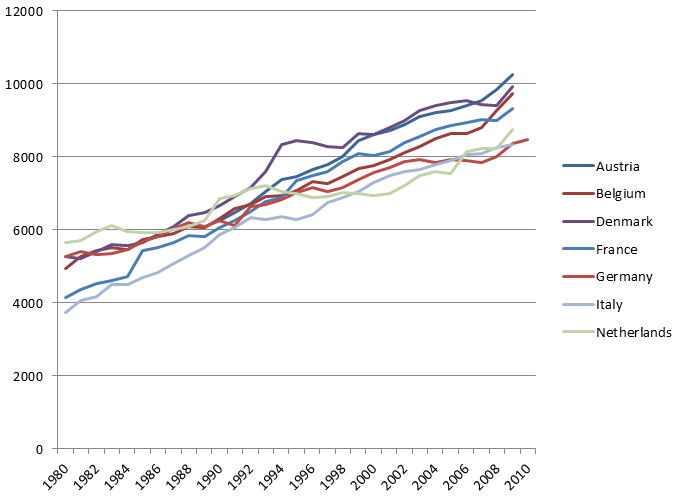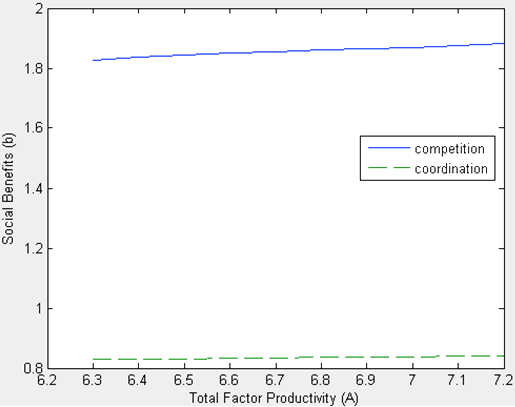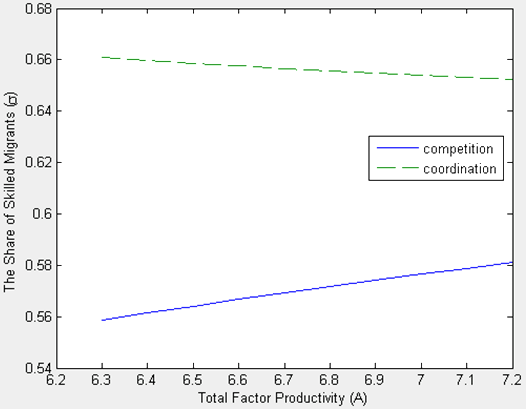European welfare and migration policies are strikingly different from states within the US. Over the last half century, Europe ended up with 85% of all unskilled migrants to developed countries, whereas the US retains its innovative edge by attracting 55% of the world-educated migrants.
Migration facts
Overall, the European migration exhibits significant bias toward low-skilled migrants (see Boeri et al. 2002 and Boeri 2010). Table 1 compares the stocks of migrants by educational attendance between the EU-15 and the US. Indeed, we can see that more than 40% of the stock of migrants in the US is with a tertiary education, whereas the corresponding figure for the EU-15 is less than 25%.
Table 1. The Stocks of migrants by education level, attendance, US and the EU-15, 1990 and 2000
Source: International Organisation for Migration (IOM) and OECD.
Generosity of the welfare state
The core EU member states have remarkably more generous welfare states than their counterparts in the US (see Figure 1).
Figure 1. Social expenditures per capita in the US and selected EU countries, 1980-2010
Source: OECD library.
Figure 1, which depicts the social expenditures in the core EU countries and the US, (at PPP 2000 USD), confirms that expenditures are significantly lower in the US relative to the EU.
Intra-union competition and coordination
We now bring out an analytical argument for the existence of these key differences, based on Tiebout’s framework (1956) of competition among local governments. We envision ‘utility-taking’ behaviour of states within an economic union, analogous to ‘price-taking’ behaviour among firms.
Specifically, we develop a model of a stylised economy with a group (union) of small countries. This setup may capture the gist of the state-designed policy competition that takes place among the members of the EU.
There is free mobility of goods and capital among them. They are also destination countries for migrants from the rest of the world. These migrants are generally poorer than the native-born residents of the countries. Each country in the union determines its own tax/ benefit and migration policies, in competition with the other countries.
Because of the intra-union free migration, utilities are equal for the union residents, differentiated by skill and origin. Each union-member country takes union-wide utility levels at given too; that is, each country is also a ‘utility-taker’.
Due to competition among union member countries, the reservation utility levels that clear the market for migrants from the rest of the world are equal across union member countries. Under the competition regime – like the one in EU member countries – union members compete with each other in the attempt to achieve as high utility level for the majority as possible; in the sense that each country determines its fiscal and migration policy variables independently of the other union-member countries, taking their policies as given (a Nash-equilibrium).
Presumably, a low-skilled majority voter opts to admit skilled migrants for two reasons:
- First, such migrants are net contributors to the finances of the welfare state, that is, the tax that each one pays exceeds the benefit she receives.
- For any given stock of capital (and volume of migration) increasing the share of skilled migrants raises the wage of the low-skilled (native-born and migrants alike), due to the factor-substitution built in the Cobb-Douglas production function.
Therefore, if the low-skilled form the majority, they will admit only skilled migrants. On the other hand, a high-skilled majority (which is the case at hand) may opt for both types of migrants. Low-skilled migration raises the wage of the skilled due to a factor substitution effect, but imposes a fiscal burden on the skilled because low-skilled migrants are not countries of the welfare state. Skilled migration lowers the wage of the skilled, but contributes positively to the finances of the welfare state.
An alternative institutional regime is for the union-member states to coordinate their fiscal and migration policies to their mutual benefit. Naturally, such coordination can come only at the expense of the migrants from the rest of the world.
The competitive institutional regime of coordination among union member states may capture the gist of the federal system of the US. In particular, the federal government is the governing body that sets the migration policy and the bulk of the fiscal policy.
The very advantage of coordination over competition is that the former allows the union member countries (states) to take into account the effect of policy on economic variables (prices, reservation utilities) that each individual country takes as given under competition. The union member countries are no longer price- or utility- takers in the coordination regime as they were in the competitive regime.
Intra-union competition versus coordination
Based on numerical simulations of our model, Figure 2 shows that in the coordination regime, fiscal and migration policies allow the union member states to offer less generous social benefits than when they do compete with each other. The rationale for this result is rooted in a fiscal leakage externality associated with migration. What is such a fiscal leakage externality? 1
Recall that the low-skilled migrants not only possess no capital, they also have low wages, pay low labour income taxes, and contribute to the financing of the social benefits less than their native-born, high-skilled counterparts. Each union member country in a competitive regime evidently balances on the margin the gains and losses from migration. In doing so, each country (being a utility-taker) takes the reservation utilities which govern immigration as given. It ignores the fact that to elicit the marginal migrant, a fiscal-migration policy must accord to him or her the same utility offered by other union member countries. As a result, every union member offers migrants too generous social benefits, and admits too high a share of low-skilled migrants.
As expected, the cooperating states facing an upward-slopping supply of migrants (of both types) exploit their market power by admitting smaller numbers of high-skilled and low-skilled migrants, as compared to the case when they compete with each other. Indeed, Figure 3 demonstrates that the union member states admit a higher share of low-skilled migrants when they compete with each other than when they cooperate.
Figure 2. Social benefits by Total Factor Productivity: Competition and coordination
Figure 3. Skill composition of migration by Total Factor Productivity: Competition and coordination
Can such fiscal leakage externality be big enough to have the potential of explaining, in part, key policy differences between the EU and the US? We do not know. We can only note that the fiscal-leakage externality, which is essentially at the root of our argument, is generated by income differences between migrants and the native-born. In reality, these differences are very significant.
Conclusion
The ageing of the population is another fundamental driving force that sets the EU and the US apart. In 2010, the proportion of people 65 and older constituted 13.1% in the US, whereas in the core EU countries it is significantly larger: 20.8% in Germany, 20.3% in Italy, 16.8 % in France, and 16.6 % in the UK. The US population is projected to grow faster in the second half of the 21st century, and to age slower than the populations of its partners in Europe. The ageing of the population affects the political power balance, and thereby the generosity of the welfare state and its migration policies. A more aged society would naturally entail more political influence for the old who opt for a more generous welfare state. On the other hand, the working young, who finance the welfare state, are more reluctant to increase its generosity. In Razin and Sadka (forthcoming), we argue that there are two differences between the US and the EU. These are the degree of coordination among the union member states and the ageing of the population. They both contribute to our understanding of the observed policy differences between the two otherwise similar unions: the generosity of the welfare state and the skill composition of migration.
References
Boeri, T (2008), “Brain Gain: A European Approach”, CESifo Forum, 3 pp. 30-34.
Boeri, T (2010), “Immigration to the Land of Redistribution,” Economica 77, 651-687
Razin, A and E Sadka, (forthcoming), Migration and Welfare State: Why is America Different from Europe? Palgrave Publishing House.
Razin A, E Sadka, and P Swagel (2002a), “Tax Burden and Migration: a Political Economy Theory and Evidence.” Journal of Public Economics 85(2), pp. 167-190.
Razin A, E Sadka, and P Swagel. (2002b), “The Aging Population and the Size of the Welfare State.” The Journal of Political Economy 66(6):467-482.
Tiebout, C M (1956), “A Pure Theory of Local Expenditures.” The Journal of Political Economy 64(5):416-424.
Footnote
1 Fiscal leakage effects in the presence of ageing of the population and migration, is first analysed in the context of the generosity of the welfare state in the presence of ageing and the skill composition of migration by Razin et al. (2002a and 2002b).






